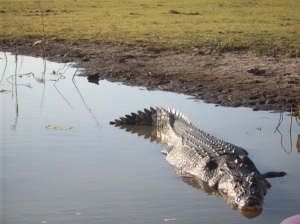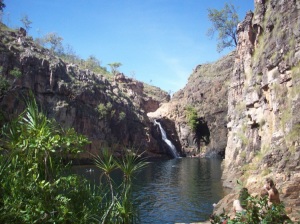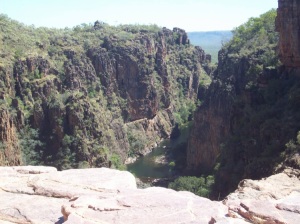One thing ahead: If you visit Kakadu National Park only once, it should be in the dry season (roughly April to September). The wet season comes with lots and lots of rain so that some intriguing hiking paths must be closed for safety reasons regularly. Also, remember that you may encounter saltwater crocodiles (“salties”) aroung the ‘top end’ of Australia, and not only in the sea, but also in every type of inshore water that has a visible or underground connection with it. So stay safe – keep away from water (except the one that comes from the tap)!
How to get there and around?
Kakadu National Park is a different experience, depending whether you go in the dry or in the wet season. You can either join a guided tour (I’d reccommend 3 days at least) or come and drive around in your own vehicle. Going on your own and discovering the place in your own pace is always the better option of course, but the streets (or rather dirt roads) through Kakadu NP are party only accessible by 4-WD (even more so in the wet season). You will also need your own camping equipment – if you need to buy some of that, check the notice boars in hostels in Darwin. It is not too rare that backpackers want to get rid of too much and too heavy camping equipment after they’ve seen Kakadu National Park, and before they travel on.
From Darwin, the best and actually only place to stay before starting on your Kakadu trip, you can easily get to the National Park and the Bowali Visitor Centre in Jabiru by following Arnhem highway.
What’s there to see?
Getting a map from the Visitor Centre in Jabiru and planning your trip (including overnight stays) a little bit ahead can be worthwile. Driving distances are easily underestimated, because most roads are merely dirt paths and you have to slow down. Here’s a list of amazing sights in Kakadu you should try not to miss:
- Jim Jim Falls and Twin Falls – these are accessible only in the dry season; which means that in the wet season, when the falls are at their most spectacular, it is impossible to drive any vehicle into the area. In the dry season, when access is possible via a 60 km dirt road (partly for four-wheel drive vehicles only), the water dries up and the falls often don’t fall. You can still take a boat shuttle through the spectacular Twin Falls Gorge.
- Yellow water billabong and cruise – a typical wetlands and swamp landscape: see lots of wildlife, birds, crocodiles, all sorts of fish…
- Ubirr rock and Nourlangie rock: Aboriginal rock art and culture
- Maguk (Barramundi Gorge)
- Gunlom Falls – take a steep path up the hills to the top end of the falls, enjoy the rock pools up there and the views of the southern hills and ridges from the lookout point
- The Escarpment – see the stunningly sharp rocky edge of the Kakadu escarpment and enjoy the 360 degree view
What else do I need to know about Kakadu National Park?
The National Park is actually Aboriginal land, the Aboriginal owners used to call the place Gagadju (the word ‘kakadu’ derives from that). Aboriginal people now take part in managing the park, but their real living space has become Arnhem land – Kakadu National Park is only a part of it. Arnhem land stretches all the way from Kakadu’s eastern boundaries to Gove peninsula, on the eastern shore of the Top End.
All this is Aboriginal land and heritage – you should be aware of that when visiting, and acknowledge that you are merely a visitor in what is other people’s sanctuary and altar. Because a lot of the natural sites are spiritual, holy places for the Indigenous people. So, just like you shouldn’t walk on or climb Ulury/Ayer’s Rock: Be aware that Kakadu National Park is a gift, it is not just a playground.




I would add Ubirr in the Dry and also Mamukala Wetlands for bird life…one of my favourite places. Oh, and Nourlangie Rock for the art work and the nearby Anbangbang billabong for birdlife – but steer clear from the water’s edge.